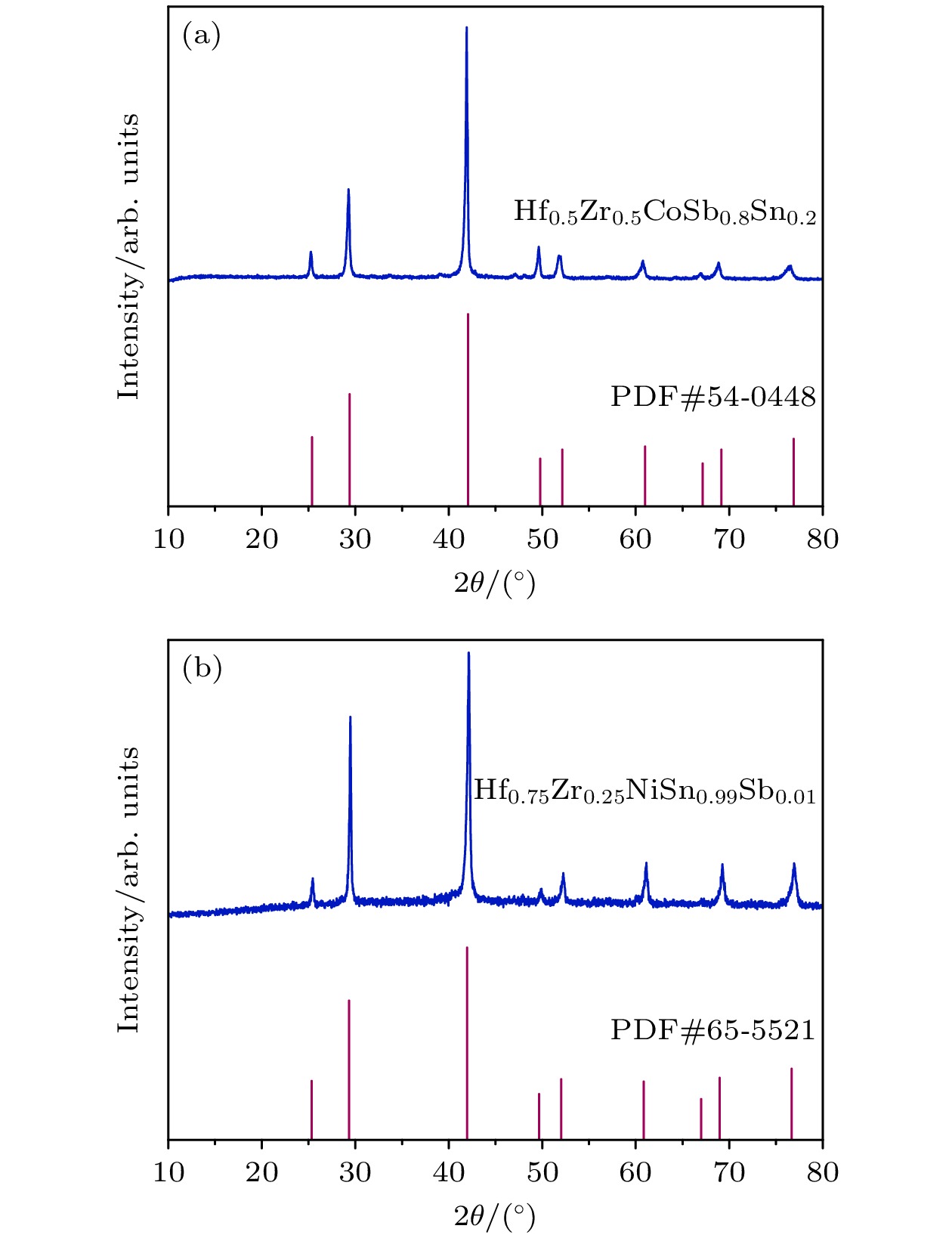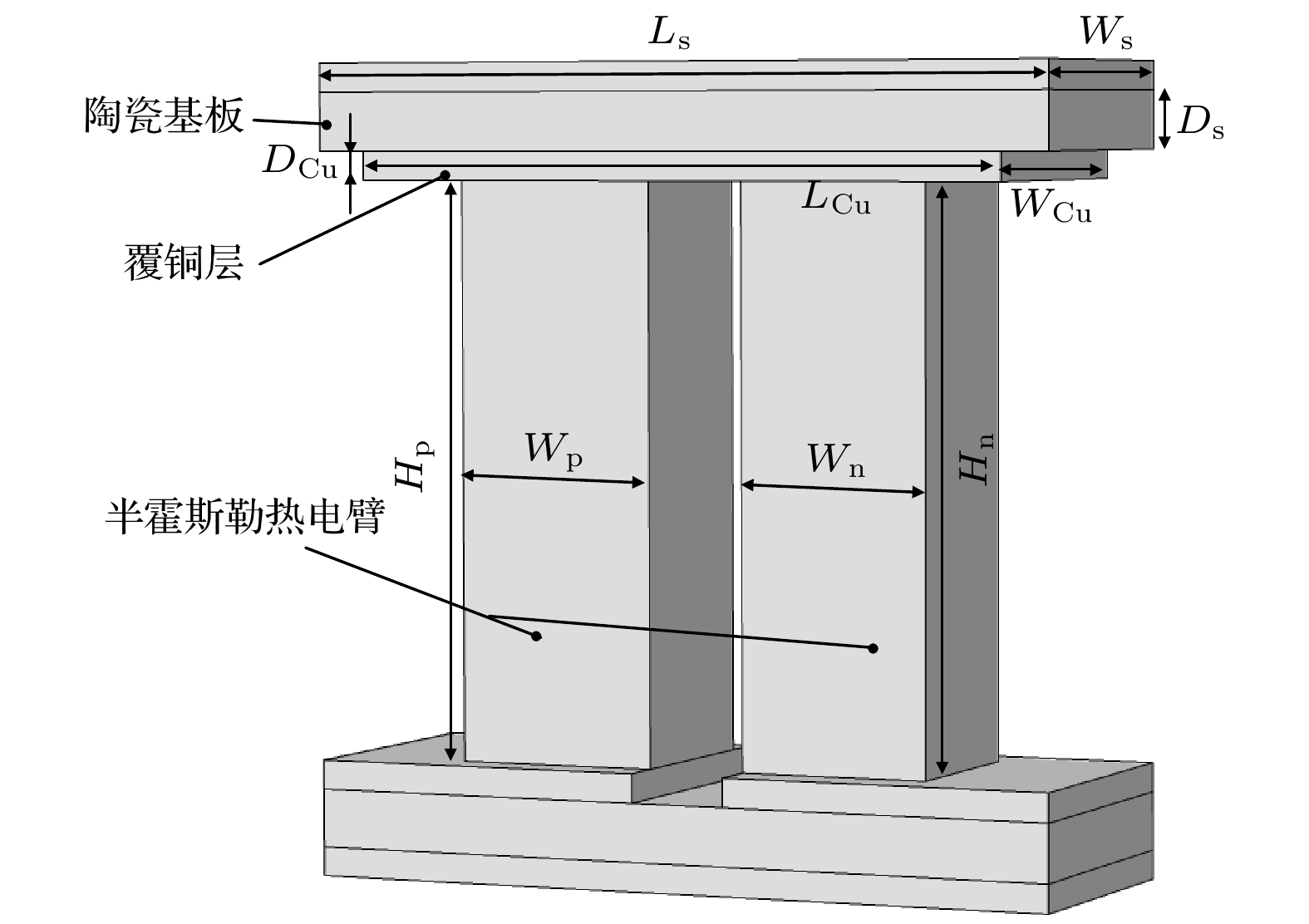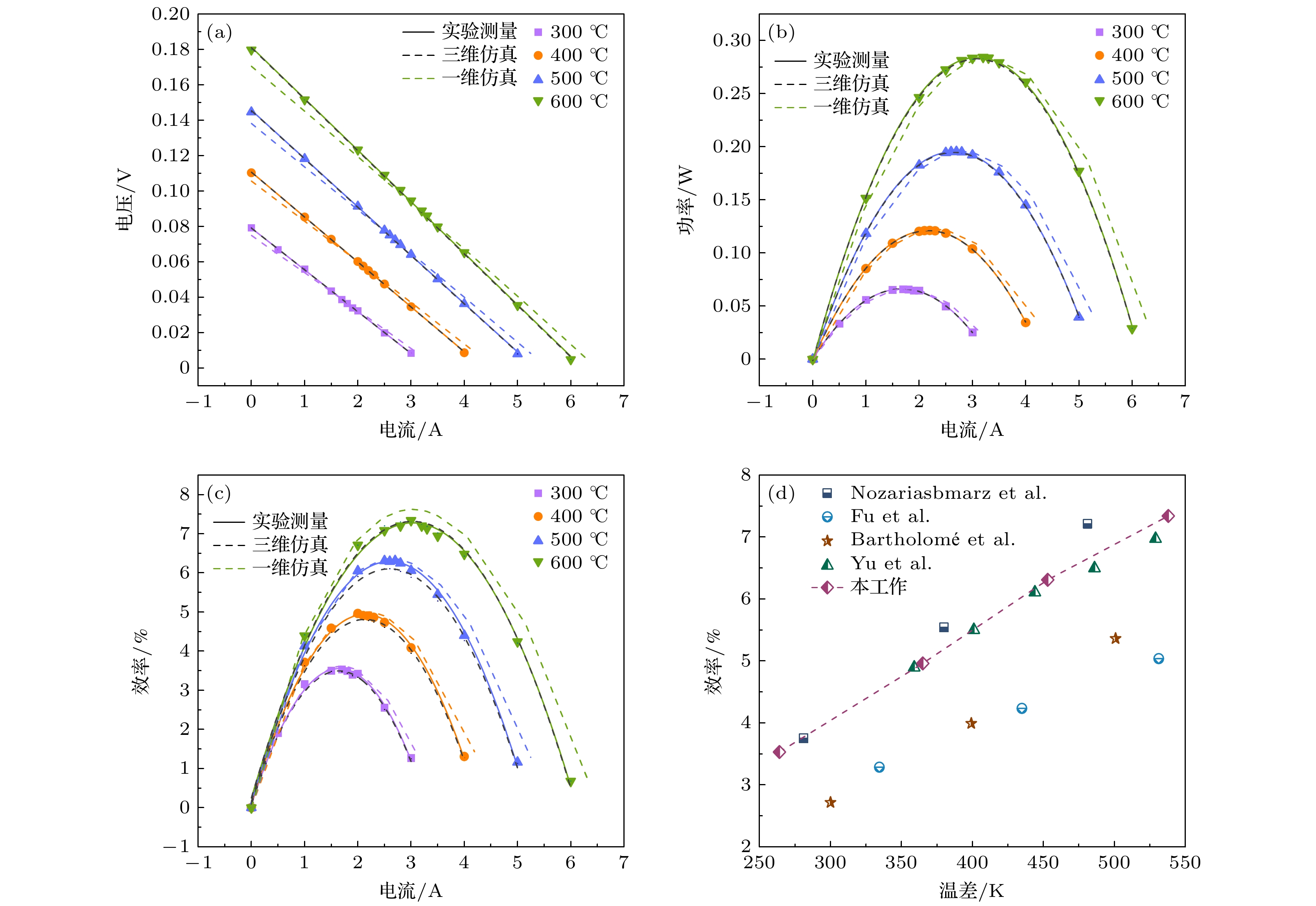-
Due to the ability to directly convert thermal energy into electrical energy, thermoelectric devices operating in the medium-to-high temperature range hold significant potential for applications such as deep space exploration and industrial waste heat recovery. Among candidate materials, half-Heusler alloys have emerged as promising options for device fabrication in this temperature range, owing to their excellent mechanical properties, thermal stability, and favorable thermoelectric performance. However, research on half-Heusler-based thermoelectric devices remains far behind study of the materials, which limits their large-scale industrial application. In this study, high-performance P-type Hf0.5Zr0.5CoSb0.8Sn0.2 and N-type Hf0.75Zr0.25NiSn0.99Sb0.01 half-Heusler alloys are firstly synthesized. Then the single-pair thermoelectric module is successfully brazed and assembled by using the graphite mold designed by ourselves. After that, three-dimensional (3D) finite element modeling and one-dimensional (1D) numerical modeling are conducted to simulate the module behaviors, and their results are highly consistent with experimental measurements, thereby validating the accuracy of the simulation models. Using the established simulation models, the influence of geometric parameters on module performance is investigated. The result shows that optimizing the leg height and cross-sectional area ratio is critical for achieving maximum conversion efficiency. Additionally, a self-integrated comprehensive testing system (Model: TE-X-MS) is developed to systematically characterize key thermoelectric properties, including output power and conversion efficiency. The fabricated device achieves a maximum output power of 0.28 W and a peak conversion efficiency of 7.34% at a temperature difference of 538 K, which is comparable to the best-performing devices reported to date. These results provide valuable reference for fabricating, modeling, and characterizing the half-Heusler thermoelectric devices in practical applications.
-
Keywords:
- half-Heusler alloy /
- thermoelectric generator /
- finite element simulation /
- numerical simulation
[1] 王雅宁, 陈少平, 樊文浩, 郭敬云, 吴玉程, 王文先 2020 物理学报 69 246801
 Google Scholar
Google Scholar
Wang Y N, Chen S P, Fan W H, Guo J Y, Wu Y C, Wang W X 2020 Acta Phys. Sin. 69 246801
 Google Scholar
Google Scholar
[2] 杨士冠, 林鑫, 何俊松, 翟立军, 程林, 吕明豪, 刘虹霞, 张艳, 孙志刚 2023 物理学报 72 228401
 Google Scholar
Google Scholar
Yang S G, Lin X, He J S, Zhai L J, Chen L, Lü M H, Liu H X, Zhang Y, Sun Z G 2023 Acta Phys. Sin. 72 228401
 Google Scholar
Google Scholar
[3] 谢忠祥, 喻霞, 贾聘真, 陈学坤, 邓元祥, 张勇, 周五星 2023 物理学报 72 124401
 Google Scholar
Google Scholar
Xie Z X, Yu X, Jia P Z, Chen X K, Deng Y X, Zhang Y, Zhou W X 2023 Acta Phys. Sin. 72 124401
 Google Scholar
Google Scholar
[4] He H L, Fang Z X, Niu C P, Wu Y, Rong M Z 2021 Energy Convers. Manag. 241 114314
 Google Scholar
Google Scholar
[5] Yu K, Wu Y, He H L, Niu C P, Rong M Z, Wu D, Liu S X, Zhang Y Q 2021 J. Alloys Compd. 885 161378
 Google Scholar
Google Scholar
[6] Zhang P, Ouyang T, Tang C, He C Y, Li J, Zhang C X, Zhong J X 2021 Chin. Phys. B 30 128401
 Google Scholar
Google Scholar
[7] 许易, 许小言, 张薇, 欧阳滔, 唐超 2019 物理学报 68 247202
 Google Scholar
Google Scholar
Xu Y, Xu X Y, Zhang W, Ouyang T, Tang C 2019 Acta Phys. Sin. 68 247202
 Google Scholar
Google Scholar
[8] Lu J Y, Cui C F, Ouyang T, Li J, He C Y, Tang C, Zhong J X 2023 Chin. Phys. B 32 048401
 Google Scholar
Google Scholar
[9] Zhang P, Ouyang T, Tang C, He C Y, Li J, Zhang C X, Zhong J X 2020 Chin. Phys. B 29 118401
 Google Scholar
Google Scholar
[10] Ovik R, Long B D, Barma M C, Riaz M, Sabri M F M, Said S M, Saidur R 2016 Renewable Sustainable Energy Rev. 64 635
 Google Scholar
Google Scholar
[11] Eddine A N, Chalet D, Faure X, Faure X, Chessé P 2018 Energy 143 682
 Google Scholar
Google Scholar
[12] Haddad C, Périlhon C, Danlos A, François M X, Descombes G 2014 Energy Procedia 50 1056
 Google Scholar
Google Scholar
[13] Shen Z G, Tian L L, Liu X 2019 Energy Convers. Manag. 195 1138
 Google Scholar
Google Scholar
[14] Holgate T C, Bennett R, Hammel T, Caillat T, Keyser S, Sievers B 2015 J. Electron. Mater. 44 1814
 Google Scholar
Google Scholar
[15] 柏胜强, 廖锦城, 夏绪贵, 陈立东 2020 深空探测学报 7 525
 Google Scholar
Google Scholar
Bai S Q, Liao J C, Xia X G, Chen L D 2020 J. Deep Space Explor. 7 525
 Google Scholar
Google Scholar
[16] Xiao Y, Zhao L D 2018 npj Quantum Mater. 3 55
 Google Scholar
Google Scholar
[17] Rogl G, Rogl P 2017 Curr. Opin. Green Sustainable Chem. 4 50
 Google Scholar
Google Scholar
[18] Huang L H, Zhang Q Y, Yuan B, Xiang L, Yan X, Ren Z F 2016 Mater. Res. Bull. 76 107
 Google Scholar
Google Scholar
[19] Gelbstein Y, Gotesman G, Lishzinker Y, Dashevsky Z, Dariel M P 2008 Scr. Mater. 58 251
 Google Scholar
Google Scholar
[20] Rull-Bravo M, Moure A, Fernández J F, Martín-González M 2015 RSC Adv. 5 41653
 Google Scholar
Google Scholar
[21] Rogl G, Grytsiv A, Gürth M, Tavassoli A, Ebner C, Wünschek A, Puchegger S, Soprunyuk V, Schranz W, Bauer E, Müller H, Zehetbauer M, Rogl P 2016 Acta Mater. 107 178
 Google Scholar
Google Scholar
[22] Silpawilawan W, Kurosaki K, Ohishi Y, Muta H, Yamanaka S 2017 J. Mater. Chem. C 5 6677
 Google Scholar
Google Scholar
[23] Poon S J 2018 Metals 8 989
 Google Scholar
Google Scholar
[24] He H L, Zhao Y B, Ren H R, Niu C P, Fang Z X, Wu Y, Rong M Z 2022 Appl. Therm. Eng. 215 118900
 Google Scholar
Google Scholar
[25] Nozariasbmarz A, Saparamadu U, Li W, Kang H B, Dettor C, Zhu H T, Poudel B, Priya S 2021 J. Power Sources 493 229695
 Google Scholar
Google Scholar
[26] Yu J J, Xing Y F, Hu C L, Huang Z J, Qiu Q Y, Wang C, Xia K Y, Wang Z Y, Bai S Q, Zhao X B, Chen L D, Zhu T J 2020 Adv. Energy Mater. 10 2000888
 Google Scholar
Google Scholar
[27] Xing Y F, Liu R H, Liao J C, Zhang Q H, Xia X G, Wang C, Huang H, Chu J, Gu M, Zhu T J, Zhu C X, Xu F F, Yao D X, Zeng Y P, Bai S Q, Uher C, Chen L D 2019 Energy Environ. Sci. 12 3390
 Google Scholar
Google Scholar
[28] 苗圃, 韩屾, 高梓恒, 付晨光, 朱铁军 2022 中国材料进展 41 1029
 Google Scholar
Google Scholar
Miao P, Han S, Gao Z H, Fu C G, Zhu T J 2022 Mater. Chin. 41 1029
 Google Scholar
Google Scholar
[29] Moh'd A A N, Tashtoush B M, Jaradat A A 2015 Energy 90 1239
 Google Scholar
Google Scholar
[30] Chen W H, Huang S R, Wang X D, Wu P H, Lin Y L 2017 Energy 133 257
 Google Scholar
Google Scholar
[31] Meng F K, Chen L G, Sun F R 2016 Low-Carbon Technol. 11 375
 Google Scholar
Google Scholar
[32] Ouyang Z, Li D 2016 Sci. Rep. 6 24123
 Google Scholar
Google Scholar
-
图 7 热端温度分别为300 ℃, 400 ℃, 500 ℃, 600 ℃时单对器件在不同电流负载下的特性变化 (a) 电压; (b) 输出功率; (c) 转换效率. (d) 本文不同温差下的最大转换效率与其他文献中报道的半赫斯勒器件的最大效率的对比
Figure 7. Characteristic curves of a single pair of devices under different current loads when the hot end temperatures are 300 ℃, 400 ℃, 500 ℃ and 600 ℃ respectively: (a) Voltage; (b) output power; (c) conversion efficiency. (d) Comparison between the maximum conversion efficiency under different temperature differences in this work and other literatures.
表 1 单对器件建模参数
Table 1. Single pair device’s modeling parameters.
参 数 数 值 陶瓷基板长度Ls/mm 8 陶瓷基板宽度Ws/mm 3 陶瓷基板厚度Ds/mm 0.6 覆铜层长度LCu/mm 7 覆铜层宽度WCu/mm 3 覆铜层厚度DCu/mm 0.3 P型热电臂宽度Wp/mm 2.1 P型热电臂高度Hp/mm 6 N型热电臂宽度Wn/mm 2 N型热电臂宽度Hn/mm 6 表 2 热电材料物性参数
Table 2. Physical parameters of thermoelectric materials.
参数 温度相关表达式 P型 S/(μV·K–1) $-2.37478\times 10^{-13}T^3+2.00399\times 10^{-10} T^2 + 1.45119\times 10^{-7} T + 0.0000646145 $ σ/(S⋅cm–1) $-6.40884\times 10^{-9}T^3+0.0000127913T^2 -0.00898933T + 6.35472 $ κ/(W⋅m–1⋅K–1) $-0.000461149T^3 + 1.02189T^2 -825.929T +327500.0 $ N型 S/(μV⋅K–1) $2.37915\times 10^{-13}T^3 -1.39249\times 10^{-10}T^2 -2.14638\times 10^{-7} T -0.0000648974 $ σ/(S⋅cm–1) $-1.25489\times 10^{-8} T^3 + 0.0000285845T^2 -0.0223619T +10.403 $ κ/(W⋅m–1⋅K–1) $0.0000727835T^3 + 0.0782446T^2 -271.589T +266246.0$ -
[1] 王雅宁, 陈少平, 樊文浩, 郭敬云, 吴玉程, 王文先 2020 物理学报 69 246801
 Google Scholar
Google Scholar
Wang Y N, Chen S P, Fan W H, Guo J Y, Wu Y C, Wang W X 2020 Acta Phys. Sin. 69 246801
 Google Scholar
Google Scholar
[2] 杨士冠, 林鑫, 何俊松, 翟立军, 程林, 吕明豪, 刘虹霞, 张艳, 孙志刚 2023 物理学报 72 228401
 Google Scholar
Google Scholar
Yang S G, Lin X, He J S, Zhai L J, Chen L, Lü M H, Liu H X, Zhang Y, Sun Z G 2023 Acta Phys. Sin. 72 228401
 Google Scholar
Google Scholar
[3] 谢忠祥, 喻霞, 贾聘真, 陈学坤, 邓元祥, 张勇, 周五星 2023 物理学报 72 124401
 Google Scholar
Google Scholar
Xie Z X, Yu X, Jia P Z, Chen X K, Deng Y X, Zhang Y, Zhou W X 2023 Acta Phys. Sin. 72 124401
 Google Scholar
Google Scholar
[4] He H L, Fang Z X, Niu C P, Wu Y, Rong M Z 2021 Energy Convers. Manag. 241 114314
 Google Scholar
Google Scholar
[5] Yu K, Wu Y, He H L, Niu C P, Rong M Z, Wu D, Liu S X, Zhang Y Q 2021 J. Alloys Compd. 885 161378
 Google Scholar
Google Scholar
[6] Zhang P, Ouyang T, Tang C, He C Y, Li J, Zhang C X, Zhong J X 2021 Chin. Phys. B 30 128401
 Google Scholar
Google Scholar
[7] 许易, 许小言, 张薇, 欧阳滔, 唐超 2019 物理学报 68 247202
 Google Scholar
Google Scholar
Xu Y, Xu X Y, Zhang W, Ouyang T, Tang C 2019 Acta Phys. Sin. 68 247202
 Google Scholar
Google Scholar
[8] Lu J Y, Cui C F, Ouyang T, Li J, He C Y, Tang C, Zhong J X 2023 Chin. Phys. B 32 048401
 Google Scholar
Google Scholar
[9] Zhang P, Ouyang T, Tang C, He C Y, Li J, Zhang C X, Zhong J X 2020 Chin. Phys. B 29 118401
 Google Scholar
Google Scholar
[10] Ovik R, Long B D, Barma M C, Riaz M, Sabri M F M, Said S M, Saidur R 2016 Renewable Sustainable Energy Rev. 64 635
 Google Scholar
Google Scholar
[11] Eddine A N, Chalet D, Faure X, Faure X, Chessé P 2018 Energy 143 682
 Google Scholar
Google Scholar
[12] Haddad C, Périlhon C, Danlos A, François M X, Descombes G 2014 Energy Procedia 50 1056
 Google Scholar
Google Scholar
[13] Shen Z G, Tian L L, Liu X 2019 Energy Convers. Manag. 195 1138
 Google Scholar
Google Scholar
[14] Holgate T C, Bennett R, Hammel T, Caillat T, Keyser S, Sievers B 2015 J. Electron. Mater. 44 1814
 Google Scholar
Google Scholar
[15] 柏胜强, 廖锦城, 夏绪贵, 陈立东 2020 深空探测学报 7 525
 Google Scholar
Google Scholar
Bai S Q, Liao J C, Xia X G, Chen L D 2020 J. Deep Space Explor. 7 525
 Google Scholar
Google Scholar
[16] Xiao Y, Zhao L D 2018 npj Quantum Mater. 3 55
 Google Scholar
Google Scholar
[17] Rogl G, Rogl P 2017 Curr. Opin. Green Sustainable Chem. 4 50
 Google Scholar
Google Scholar
[18] Huang L H, Zhang Q Y, Yuan B, Xiang L, Yan X, Ren Z F 2016 Mater. Res. Bull. 76 107
 Google Scholar
Google Scholar
[19] Gelbstein Y, Gotesman G, Lishzinker Y, Dashevsky Z, Dariel M P 2008 Scr. Mater. 58 251
 Google Scholar
Google Scholar
[20] Rull-Bravo M, Moure A, Fernández J F, Martín-González M 2015 RSC Adv. 5 41653
 Google Scholar
Google Scholar
[21] Rogl G, Grytsiv A, Gürth M, Tavassoli A, Ebner C, Wünschek A, Puchegger S, Soprunyuk V, Schranz W, Bauer E, Müller H, Zehetbauer M, Rogl P 2016 Acta Mater. 107 178
 Google Scholar
Google Scholar
[22] Silpawilawan W, Kurosaki K, Ohishi Y, Muta H, Yamanaka S 2017 J. Mater. Chem. C 5 6677
 Google Scholar
Google Scholar
[23] Poon S J 2018 Metals 8 989
 Google Scholar
Google Scholar
[24] He H L, Zhao Y B, Ren H R, Niu C P, Fang Z X, Wu Y, Rong M Z 2022 Appl. Therm. Eng. 215 118900
 Google Scholar
Google Scholar
[25] Nozariasbmarz A, Saparamadu U, Li W, Kang H B, Dettor C, Zhu H T, Poudel B, Priya S 2021 J. Power Sources 493 229695
 Google Scholar
Google Scholar
[26] Yu J J, Xing Y F, Hu C L, Huang Z J, Qiu Q Y, Wang C, Xia K Y, Wang Z Y, Bai S Q, Zhao X B, Chen L D, Zhu T J 2020 Adv. Energy Mater. 10 2000888
 Google Scholar
Google Scholar
[27] Xing Y F, Liu R H, Liao J C, Zhang Q H, Xia X G, Wang C, Huang H, Chu J, Gu M, Zhu T J, Zhu C X, Xu F F, Yao D X, Zeng Y P, Bai S Q, Uher C, Chen L D 2019 Energy Environ. Sci. 12 3390
 Google Scholar
Google Scholar
[28] 苗圃, 韩屾, 高梓恒, 付晨光, 朱铁军 2022 中国材料进展 41 1029
 Google Scholar
Google Scholar
Miao P, Han S, Gao Z H, Fu C G, Zhu T J 2022 Mater. Chin. 41 1029
 Google Scholar
Google Scholar
[29] Moh'd A A N, Tashtoush B M, Jaradat A A 2015 Energy 90 1239
 Google Scholar
Google Scholar
[30] Chen W H, Huang S R, Wang X D, Wu P H, Lin Y L 2017 Energy 133 257
 Google Scholar
Google Scholar
[31] Meng F K, Chen L G, Sun F R 2016 Low-Carbon Technol. 11 375
 Google Scholar
Google Scholar
[32] Ouyang Z, Li D 2016 Sci. Rep. 6 24123
 Google Scholar
Google Scholar
Catalog
Metrics
- Abstract views: 3472
- PDF Downloads: 29
- Cited By: 0














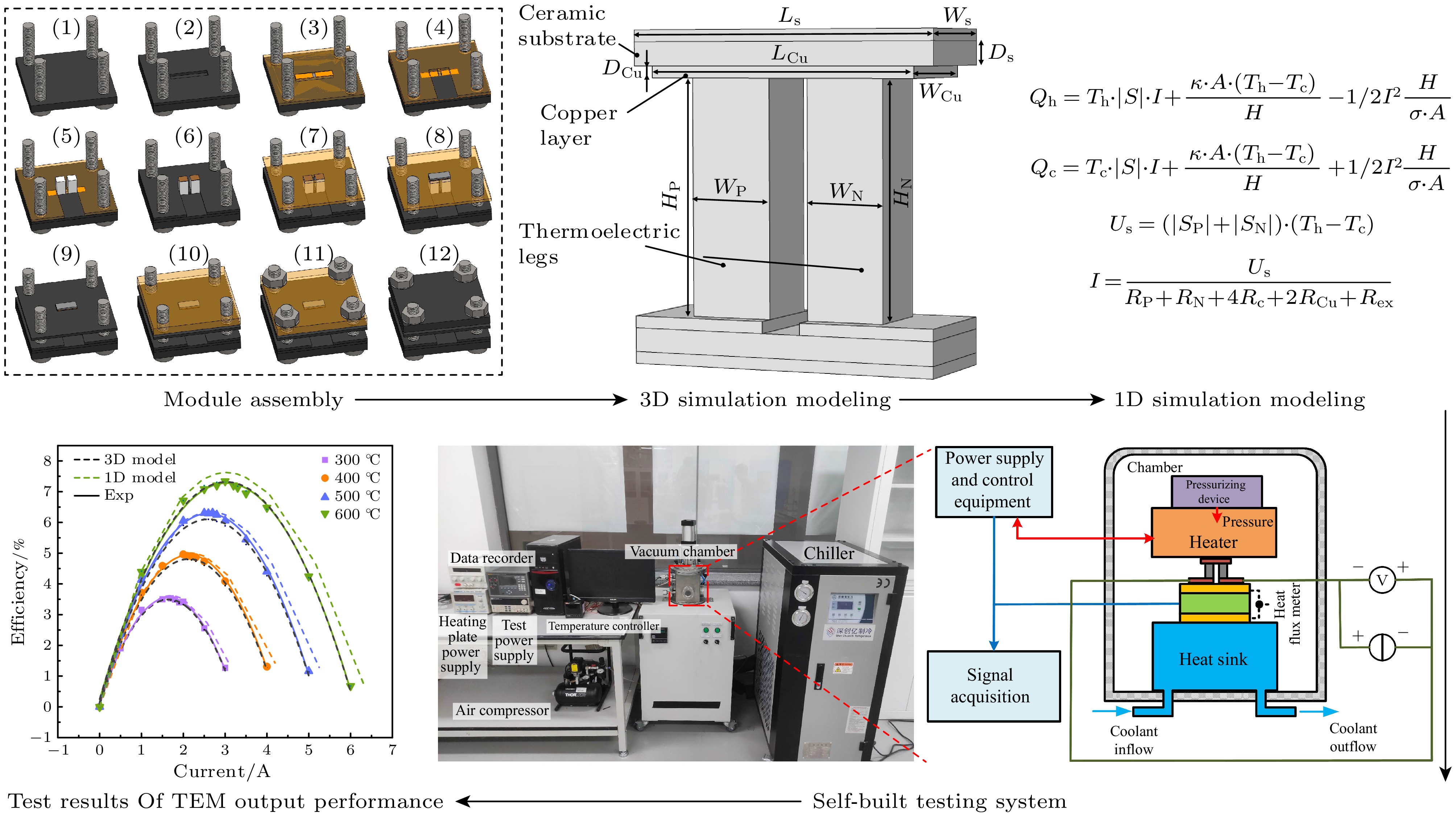
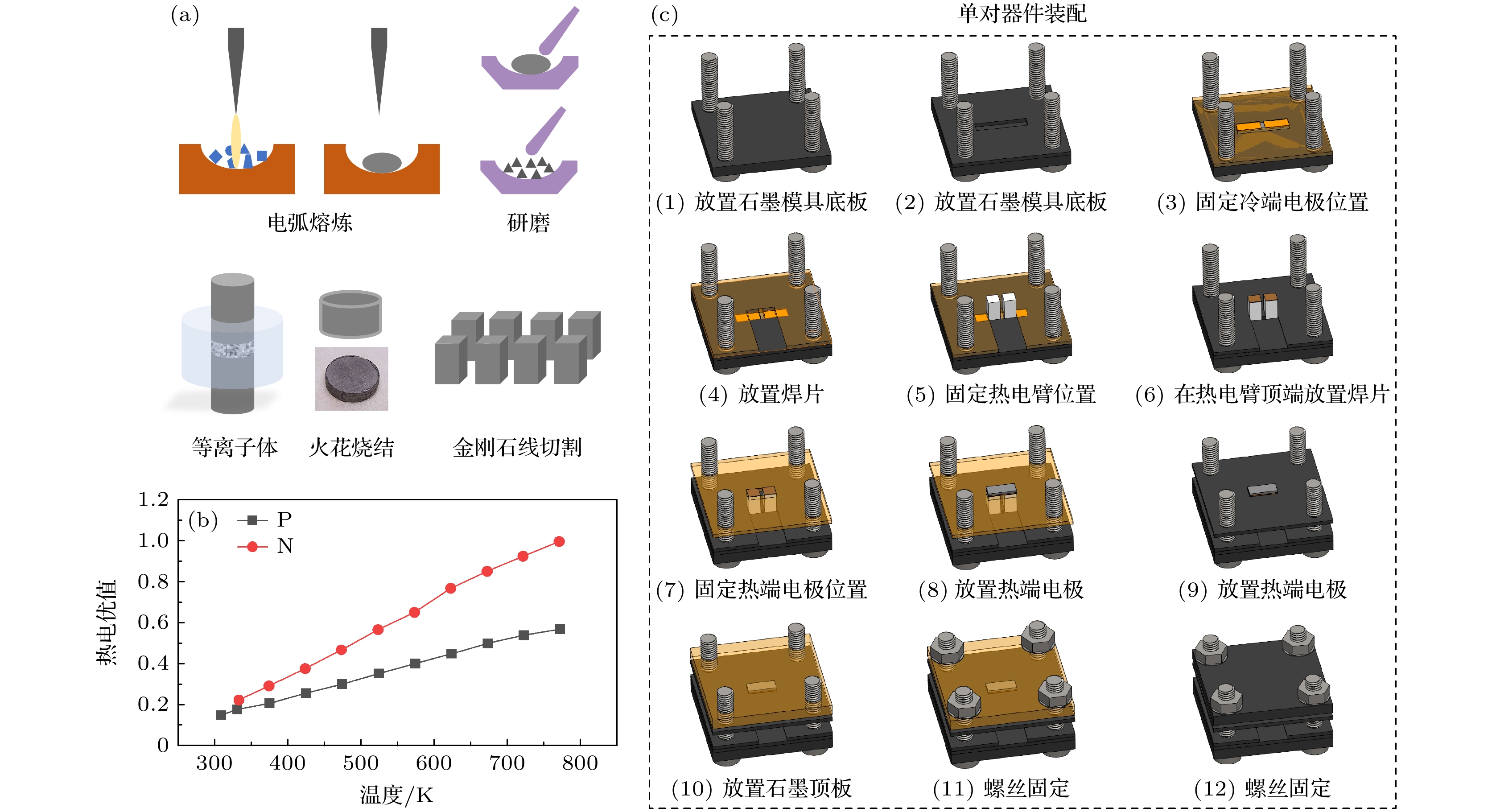
 DownLoad:
DownLoad:
